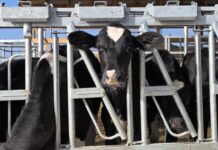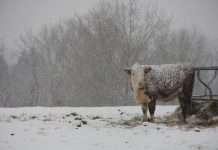As the art of better grazing management progresses, farmers push toward year-round grazing. Recently many economic studies have indicated livestock producers who manage grazing have a higher net profit per animal unit than conventional grazers. Is year-round grazing possible?
In Ohio, many producers are currently relying heavily on standing forage throughout the year. However, there are definitely strategies which must be utilized to accomplish better forage utilization as we reach toward year-round grazing.
Reduce feed cost. Probably the most significant reduction in feed cost and movement toward a longer grazing season is accomplished through stockpiled tall fescue.
A comparison of long-term winter feeding records at Missouri’s Forage Systems Research Center indicated that cows grazing stockpiled tall fescue pastures have a lower daily feed cost than cows feeding on hay by a margin of 50 to 60 cents per cow.
Creating grass-legume mixtures to offset reduced cool-season grass production in the summer and improve forage quality is another important management strategy. Cool-season legumes such as alfalfa, red clover, ladino clover and birdsfoot trefoil have a slightly higher optimum growth temperature, are deeper rooted and of higher nutritional quality than cool-season grasses.
Interseeding legumes into pastures can help in extending the summer grazing season, improve forage quality and yield and help to reduce the negative effects of fescue endophyte. However, without proper management legumes will not persist in pastures.
Annuals and perennials. We see more uses of both summer and winter annuals as grazers move toward year-round grazing.
Annuals and, in some cases perennials, which have a defined growth period, are being utilized primarily to offset cool-season grass production in midsummer, late fall, winter and early spring. Warm-season native tall grass species such as bluestem, eastern gamagrass, indiangrass and switchgrass grow when cool-season grasses are dormant during the hottest summer months.
We have warm-season annual grasses, such as corn, sudangrass, crabgrass and pearl millet, which also grow during the hottest summer months and are of good forage quality while being high yielding.
Cool-season annual crops, both brassica species and grasses are being utilized to supply standing forage in late fall, winter and early spring. Rye, barley, wheat, triticale and oats have all been utilized in the fall and winter for grazing.
Brassica species, such as turnips, rape and kale, provide winter forage and can be seeded with annual cereals. In mixed crop and livestock operations, corn stalks can provide a significant number of grazing days and when over-seeded with a winter annual significantly extend the grazing season.
Utilize better. The keys to year-round grazing: Better utilize what you have through managed grazing. Make good use of the spring surplus with additional animals, moving through pastures quickly, or cutting for hay. Strategically fertilize.
Don’t over-fertilize pastures early in the spring making it more difficult to manage the early spring flush. Strategically utilize nitrogen at quantities and at times which are economically effective.
Stockpile fescue or orchardgrass for fall and winter grazing. Consider the use of summer or winter annuals after you have effectively utilized your existing system. Interseed legumes into grass-dominant pastures.
Consider producing a second cutting of small hay bales, which are left in the stockpiled fescue area and strip grazed during the winter months. Supplement forage with grain strategically.
We’ve quickly glossed over a few of the commonly utilized strategies for extending the grazing season. If you have questions about adopting these techniques, contact me at OSU Extension, 1112 Wheeling Avenue, Cambridge or 740-432-9300.
(The author is an Extension Agent in Agriculture and Natural Resources in Guernsey County and co-leader of the Ohio Forage Team.)












